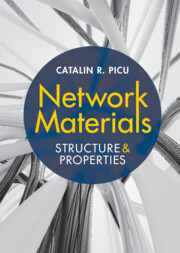Book contents
- Network Materials
- Network Materials
- Copyright page
- Contents
- Preface
- 1 Introduction
- 2 Fibers and Fiber Bundles
- 3 Fiber Interactions
- 4 Network Structure and Geometric Parameters
- 5 Affine Deformation
- 6 Mechanical Behavior and Relation to Structural Parameters
- 7 Constitutive Formulations for Network Materials
- 8 Strength and Toughness of Network Materials
- 9 Time Dependent Behavior
- 10 Networks with Fiber Surface Interactions
- 11 Composite Networks
- Index
- References
4 - Network Structure and Geometric Parameters
Published online by Cambridge University Press: 15 September 2022
- Network Materials
- Network Materials
- Copyright page
- Contents
- Preface
- 1 Introduction
- 2 Fibers and Fiber Bundles
- 3 Fiber Interactions
- 4 Network Structure and Geometric Parameters
- 5 Affine Deformation
- 6 Mechanical Behavior and Relation to Structural Parameters
- 7 Constitutive Formulations for Network Materials
- 8 Strength and Toughness of Network Materials
- 9 Time Dependent Behavior
- 10 Networks with Fiber Surface Interactions
- 11 Composite Networks
- Index
- References
Summary
The structure of network materials is stochastic. This chapter introduces the minimum set of geometric parameters required to describe the network structure. This set includes the fiber and crosslink densities, the mean segment length, a measure of preferential fiber orientation, and the connectivity index. The relation between the mean segment length and the fiber density is established for two- and three-dimensional networks with cellular and fibrous architectures. The effect of fiber tortuosity, fiber preferential alignment, and excluded volume interactions on the mean segment length are outlined. The statistics of pore sizes in networks of fibrous and cellular types is discussed in terms of the geometric network parameters. The percolation threshold, at which the first connected path forms across the network domain, is discussed for specific methods used to generate the network.
Keywords
- Type
- Chapter
- Information
- Network MaterialsStructure and Properties, pp. 95 - 127Publisher: Cambridge University PressPrint publication year: 2022



